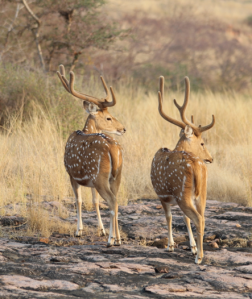Spotting chital everywhere we travelled
I can confirm that the spotted deer—or chital—is the most commonly found deer in India. We saw them almost everywhere. Even in national parks where we saw nothing else, we still saw spotted deer.
But I’m not complaining. Chital (as spotted deer are known in India) are gorgeous examples of the deer family, and a constant reminder that India’s countryside is alive with animals other than stray cows.
Chital live in herds of 10 to 30 females with a few stags. They are equally comfortable living in the extremes of dense jungle and open grasslands. The pics are an indication of their varied landscapes.
Bachelor herds are also common, and the display of antlers is quite impressive. Apparently males eat their antlers after shedding them. Most of the males we saw had abundant down on their antlers, which they must rub off before doing ‘battle’ in the mating season.
Most of chital we saw were living near to grey langur monkeys. Chital and monkeys cooperate in their efforts to stay out of the mouths of their main predators—tigers, leopards, wild dogs and jackals.
While the chital’s favourite food is grass, they are also fond of the half-eaten food langurs drop to them.
Chital are quite skittish and are sometimes frightened by the sound of a leaf falling. Anand and Deepti explained that chital have a good flight tactic. When they start to flee from perceived danger, their tail pops straight up, showing a flash of bright white. The tail remains up—as almost a signal to the predator—until the chital reaches dense bush. The deer bounds into the bush and drops the tail immediately, leaving the pursuer wondering where the tail went.
Even though they only have one fawn per year, chital numbers are healthy. Pench National Park, where we saw our first chital, has more than 15,000. I was surprised to learn that chital were introduced to Australia, especially Queensland, more than 200 years ago. Maybe I’d better go have a look.









wow nice photos
LikeLike
Thanks so much.
LikeLike
Beautiful photos, Peggy!
LikeLike
Thanks Wanda. It’s wonderful to be able to share them so easily.
LikeLike
Woozer, Peggy,
I am still amazed by your photography abilities and getting some close up shots of animals. Also, your commentary on each subject really helps in knowing about the animals and environment. I am a little surprised by the big populations of the deer… being in a third world country and many people needing food, that they deer population has not dwindled.
LikeLike
I have to admit, Sy, that a telephoto lens makes a big difference to getting close-up pics. As for the commentary, I save brochures, take notes and pics of info boards at tourist destinations, and search for any extra info online. Takes more time to pull together, but I think it’s nice to learn a bit more as I go along.
As for the large deer population, the fact that most Hindus aren’t meat eaters must make a huge difference.
LikeLike
Hi Peggy, a quick Google search found a website discussing the introduction of deer species into Australia. http://adrf.com.au/content/view/35/79/
Cheers, John
LikeLike
Thanks John. Nice addition.
LikeLike
Oh Peggy, they’re so cute that I’m amazed that you resisted going up and giving them a huge hug. And it was really interesting to read that they share with the grey langurs. It seems like such an unusual pairing.
LikeLike
They really are adorable, but too skittish to get really close to. And yes, I was surprised by their relationship with monkeys, but apparently it works well for both species.
LikeLike
Very nice pictures and nicely explained!! you also becoming naturalist… !!
LikeLike
Thanks. I’m trying. 🙂
LikeLike
Reblogged this on Vicky.
LikeLike